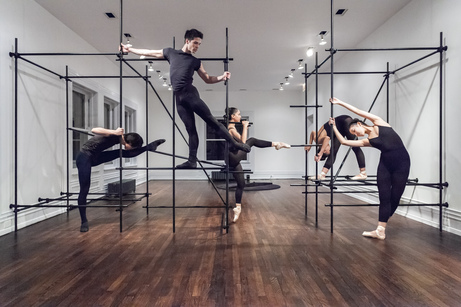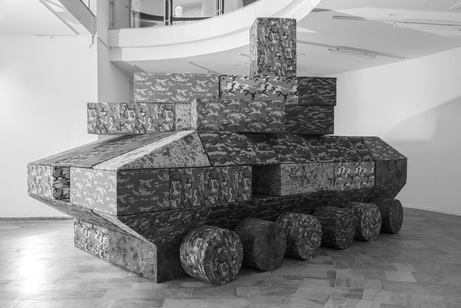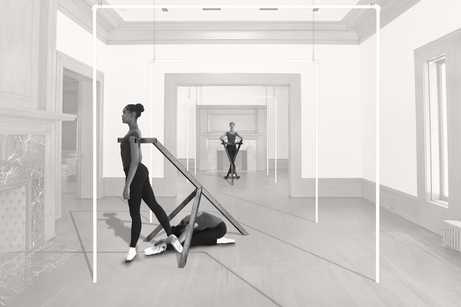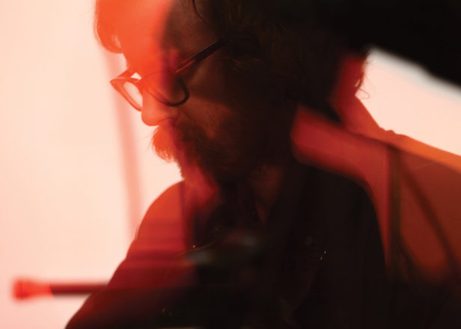Madlener House
4 West Burton Place
Chicago, Illinois 60610
Telephone: 312.787.4071
info@grahamfoundation.org

View of "Brendan Fernandes: The Master and Form." 2018, Graham Foundation, Chicago. Design: Norman Kelley; dancers: Satoru Iwasaki, Yuha Kamoto, Andrea de León Rivera, Antonio Mannino, Leah Upchurch; photo: RCH
Please join us for a performance featuring dancers from the Joffrey Academy of Dance followed by a conversation between Brendan Fernandes and Zachary Whittenburg.
Brendan Fernandes is a Chicago-based Canadian artist of Kenyan and Indian descent. He completed the Independent Study Program of the Whitney Museum of American Art (2007) and earned his MFA from the University of Western Ontario (2005) and his BFA from York University in Canada (2002). Fernandes has exhibited widely domestically and abroad, including exhibitions at the Solomon R. Guggenheim Museum, New York; Museum of Modern Art, New York; Museum of Art and Design, New York; Musée d'art contemporain de Montréal; The National Gallery of Canada, Ontario; The Brooklyn Museum, New York; The Studio Museum in Harlem, New York; Mass MoCA, North Adams, MA: The Andy Warhol Museum, Pittsburgh, PA; Deutsche Guggenheim, Berlin; Bergen Kunsthall, Norway; Stedelijk Museum, Amsterdam; The Sculpture Center, New York; The Quebec City Biennial; and the Third Guangzhou Triennial in China. His recent monograph Still Move, was published by Black Dog Press, London, fall 2016. He is currently artist-in-residence and faculty at Northwestern University in the Department of Art Theory and Practice, and is represented by Monique Meloche Gallery, Chicago.
Colorado native Zachary Whittenburg spent ten years as a professional dancer with companies including Hubbard Street Dance Chicago, BJM Danse Montréal, Pacific Northwest Ballet, and Charlotte Ballet. Since then, he has collaborated with Lucky Plush Productions, Same Planet Performance Project, and Molly Shanahan / Mad Shak on performance and choreographic work; and has lectured and led workshops nationally and internationally. From 2009-12 he was the dance editor at Time Out Chicago and has written for numerous print and online publications including regular contributions to Dance Magazine. Formerly the associate director of marketing and communication at Hubbard Street Dance Company, he currently serves as the communications and engagement director at Arts Alliance Illinois. Whittenburg remains engaged with dance as a founding member of the executive committee for the Chicago Dance History Project, and serves on the artistic advisory council for High Concept Labs.
The Joffrey Academy of Dance, Official School of The Joffrey Ballet, is committed to providing students of all ages, levels and backgrounds who have a desire to dance with a world-class education built on a foundation of classical ballet. With the talents cultivated at the Joffrey Academy, students can pursue careers as professional dancers at companies throughout the world, higher education opportunities in dance, or success in other fields. Through the Joffrey Academy’s programs, students develop a diverse set of skills including artistry, creativity, discipline and confidence, among others. The Joffrey Academy’s high-quality, educational programming forms future audiences and support for the Joffrey and builds the organization’s reputation worldwide.
Image: View of "Brendan Fernandes: The Master and Form." 2018, Graham Foundation, Chicago. Design: Norman Kelley; dancers: Satoru Iwasaki, Yuha Kamoto, Andrea de León Rivera, Antonio Mannino, Leah Upchurch; photo: RCH
For more information on the exhibition, Brendan Fernandes: The Master and Form Installation in collaboration with Norman Kelley, click here.

Andreas Angelidakis, Polemos, 2016.
|
Please join us for a talk by Jaffer Kolb, guest editor of Graham funded Log 41, which includes a special section called "Working Queer" with contributions by Ellie Abrons, Andreas Angelidakis, Annie Barrett, Caitlin Blanchfield & Farzin Lotfi-Jam, Stratton Coffman, Mustafa Faruki, Nicholas Gamso, Andrew Holder, Andrés Jaque, Jaffer Kolb & Aaron Betsky, Ang Li, Michael Meredith, Ivan L. Munuera, Joel Sanders, Rosalyne Shieh, and Michael Wang. In the discipline of architecture, "queerness" has been understood primarily in terms of how it relates to space—from bathrooms to locker rooms; spatial transgressions to phenomenal strategies of "seeing.” But what if we understood the term less as what we design and more how. That is, to think of queerness as a methodology: a way of working, an approach to research, a framework for dealing with history. In this formulation, space opens up to a range of new kinds of practices that work across scales (from building to artifact), across media (from material assembly to performance), and across forms. Together, tactics of queerness such as humor, subversion, caricature, exaggeration, and others, can be used to disorient objects themselves: to see them anew, to give them new context, to understand how they perform as socio-cultural representations. This talk will look at a few disoriented objects as a means of unpacking the potential of this queer project—to test the theory and determine whether we can affect our tools with a renewed sense of critical action. Jaffer Kolb is a designer based in New York and co-founder of the architectural practice N/A. He sometimes writes, sometimes curates, and often teaches (currently at Pratt Institute, and most recently at Princeton University's School of Architecture). He was the 2015 Muschenheim Fellow at the University of Michigan, and before that worked as a designer in New York, Chicago, and Los Angeles. His work has appeared in numerous exhibitions and has been published internationally. Previously he worked on the 13th Venice Architecture Biennial under David Chipperfield, and before that served as the US Editor of the Architectural Review. As a design journalist and critic, he has written for numerous publications internationally. He holds a Master of Architecture from Princeton University, a Master’s in Urban Planning from the London School of Economics, and his Bachelor of Arts in Film Studies from Wesleyan University. This talk is presented in relationship to our concurrent exhibition, Brendan Fernandes: The Master and Form, for more information click here. |
Image: Andreas Angelidakis, Polemos, 2017, foam and vinyl seating modules, installation view, Fridericianum, Kassel, documenta 14, photo: Nils Klinger
For more information on the exhibition, Brendan Fernandes: The Master and Form Installation in collaboration with Norman Kelley, click here.

View of "Brendan Fernandes: The Master and Form," in development, 2017, Graham Foundation, Chicago. dancer: Leah Upchurch, photo and rendering: Norman Kelley
Please join us for a opening performance and reception with Brendan Fernandes, Norman Kelley, and dancers from the Joffrey Academy of Dance on January 25, 2018 from 6–8:00 p.m.
For more information on the exhibition, Brendan Fernandes: The Master and Form Installation in collaboration with Norman Kelley, click here.

Allan Wexler, Sheathing the Rift, 2014, hand-worked inkjet on panel, 64 x 80 inches
Architect, artist, and designer Allan Wexler discusses his multi-scalar, multi-media work across a 45-year career. Allan reveals a curious, comedic, and analytical mind, offering new strategies for examining and reevaluating basic assumptions about our relationship to the built and natural environments.
Wexler's work mediates the gap between fine and applied art. Sometimes functional—tangible and tactical—sometimes theoretical, his work is often a hybrid of function and theory. In all cases, it demonstrates a commitment to reevaluating basic assumptions about what we thought we knew. Wexler's art can be broadly described as tactile poetry that is composed by reframing the ordinary with intent to sustain a narrative about landscape, nature, and architecture.
The lecture coincides with the publication of Absurd Thinking, Between Art and Design, a new monograph edited by Ashley Simone and published by Lars Müller Publishers with support from the Graham Foundation.
Allan Wexler works in the fields of architecture, design, and fine art. He is represented by the Ronald Feldman Gallery in New York City and has exhibits, teaches, and lectures internationally. Wexler teaches at Parsons School of Design in New York City. Wexler is a recipient of a Guggenheim Fellowship (2016), a Fellow of the American Academy in Rome, and a winner of both a Chrysler Award for Design Innovation, and the Henry J. Leir Prize from the Jewish Museum. He has had numerous national and international solo exhibitions, has lectured on his work internationally, and has been reviewed by major art and architecture publications. The subject of Wexler's work is the built environment. He creates drawings, multimedia objects, images, and installations that alter perceptions of domestic activities. He investigates eating, bathing, sitting, and socializing, and turns these everyday activities into ritual and theater.
Related Graham Foundation supported projects:
2016 Publication Grant to Allan Wexler for Absurd Thinking: Between Art and Design

Photo by Martin Escalante
John Wiese returns to Lampo to perform his new four-channel composition Time Column—a work that the Los Angeles-based artist says “imposes vertical time on horizontal sounds.”
John Wiese (b.1977, Ft. Leavenworth, KS) works primarily in recorded and performed sound with a focus on installation and multi-channel diffusions, as well as scoring for large ensembles. He is a prolific artist with various ongoing projects, including the concrète grindcore band Sissy Spacek, and collaborations with Evan Parker, C. Spencer Yeh, Aaron Dilloway, Kevin Drumm, Lasse Marhaug and others. In 2011 he released his 100th 7-inch record, celebrated with a retrospective exhibit and monograph. Many of these recordings were published on his Helicopter label, and on more than 50 independent labels from around the world. Wiese has toured extensively and has appeared at several leading international festivals.
In May 2012 John Wiese performed three new works for Lampo—a quad diffusion of Magical Crystal Blah, a new version of Battery Instruments, and a concrète improvisation.
Since 2010 the Graham Foundation has supported and partnered with Lampo to produce this performance series held at the Madlener House. Lampo, founded in 1997, is a non-profit organization for experimental music and intermedia projects.
Unless otherwise noted,
all events take place at:
Madlener House4 West Burton Place, Chicago
GALLERY AND BOOKSHOP HOURS
2025 Chicago Architecture Biennial
SHIFT: Architecture in Times of Radical Change
Sep 19, 2025–Feb 28, 2026
Wed–Sat, 12–5 p.m.
To make an appointment, email: bookshop@grahamfoundation.org
CONTACT
312.787.4071
info@grahamfoundation.org
Accessibility
Events are held in the ballroom on the third floor which is only accessible by stairs.The first floor of the Madlener House is accessible via an outdoor lift. Please call 312.787.4071 to make arrangements.
Copyright © 2008–2025 Graham Foundation. All rights reserved.
 PREVIOUS POSTS
PREVIOUS POSTS